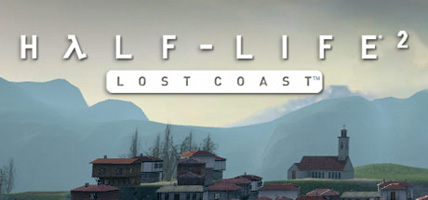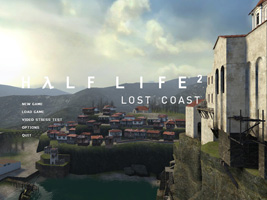

Half-Life 2: Lost Coast
developed by Valve (Bellevue, WA)
first published October 27, 2005 by Valve (online only), for use with Half-Life 2, free
~400 MB (+ some amount of Half-Life 2)
Played to completion in 28 minutes (and then 19 more for the commentary), 1/8/15
[Video of complete 30-minute playthrough with all commentary: this link should take you to timecode 1:11:00, where Lost Coast starts. If that doesn’t happen because of an ad, click it again and it should work.]
I didn’t buy this and it’s not really a game. It’s in my Steam catalog because it comes free with any purchase of Half-Life 2, so I’ve had it since 11/28/10, when I guess it must have just appeared silently.
If it’s not a game what is it? It’s a scenic little bit of deleted Half-Life 2 terrain, reworked into a “playable technology showcase,” the kind of thing developers might put together for their table at an industry convention. Yeah, there are enemies you have to shoot (about 24 dudes, 3 spider aliens, and a helicopter), some gaps you have to jump, and a “break the machine” task you have to do, but that’s hardly even par for the course at this point. It’s just to make the tech demo involving.
So what’s the tech? The main thing on show is High Dynamic Range rendering, (“HDR“), which is basically the old photographer’s trick of dodging and burning to make distinct areas of the same image each have high local contrast. Since what constitutes “distinct areas” is perceptual (rather than anything to do with the physics of light), rendering this in an aesthetically satisfying way, especially on the fly in a videogame, is fancy business.
They also show off a simulation of iris-adjustment in moving from light to dark areas. They brag a bit about the sophisticated tricks they were already doing to render water and translucent materials, and how now they’ve build HDR into those as well. They say they’ve further refined the textures of the character faces and skin. And maybe other stuff? I think those are the main things.
The graphics are the point and the graphics are very lovely. It’s 10 years later and things have come a little ways further, but not that much further. From 1985 to 1995 to 2005 are all pretty huge leaps. From there to 2014 (there’s not enough 2015 yet!) undeniably shows progress but just doesn’t feel like quite as significant a move. That’s probably because this naturalistic ideal is a dead end tunnel, the back wall of which is already well in view.
Why are we trying to make video games look like photographs, again? Nobody can remember. We’re just doing it. Because we can. I guess the point is: yes, we can! We already can. Have you seen that game with Kevin Spacey in it? Kevin Spacey is in it! So that means we’re done here, doesn’t it? That’s like when the computer finally beats mankind at chess: we can stop trying already, right? Some 40 years ago, a bunch of pioneering computer engineers said “We swear to climb this Everest: one day, 15-year-old Kevin Spacey Fowler will be inside a computer.” And huzzah, the day has at last come, and it is as wonderful as we had always hoped. Great. Now let’s please agree to move on with our lives, and bring our games with us.
It’s not going to happen that way. That’s okay, there’s room enough in games for all types. What I bemoan is not so much that those games exist as that they eat up literally billions of industry dollars (and, perhaps more to the point, equivalent skilled man-hours) that could have gone into developing other more interesting (and more interesting-looking) games. This is the same reason that the Hollywood equivalent conservatism is depressing: it’s not that Transformers: Age of Extinction is bad so much as that its budget takes the place of so much else. It’s that producers think that making a $200 million movie with no content and internationally viable explosions is a safer bet than making ten diverse $20 million movies or a $200 million movie with a point of view, and there’s nothing to stop those same producers from making that same safe bet over and over and over again.
Call of Duty: Advanced Warfare starring Kevin Fowler likely had a similar budget to Transformers: Age of Extinction, and I’m actually willing to bet (based on no knowledge at all beyond the trailer) that it has more interesting stuff in it. It undoubtedly provides more hours of entertainment. I’m just skeptical about producers’ low esteem for gamers even moreso than Hollywood’s for moviegoers, because the dumbing-down isn’t based on averaging out international tastes (exploding robots being the one thing American and Chinese moviegoers enjoy absolutely identically), it’s based on condescending to 14-year-old boys. Yes, 14-year-old boys tend to like football, basketball, guns, and cleavage, but they like other stuff too, and the people producing this stuff should know that. I can excuse their treating foreigners like aliens and dishing up whatever crap they seem to buy, but children are not aliens. We have some intuitions we can call on, right? Some human insight? There are very few expensive games rooted in human insight.
Feels too risky! I can relate.
Anyway, Lost Coast is just a tech demo in game form, but instead of just bringing it to some expo, they gave it to all their customers as a freebie, and added some Criterion-style commentary, accessed (if you turn it on) through floating speech bubbles strewn surrealistically through the game world like Magrittean litter. At the end, the boss says “This has been an experiment on our part to see if our community would find it interesting to learn more about our development process. … If people like this, we’ll keep producing this kind of content for all of our games going forward.” I was reminded of Unca’ Walt Disney using his TV show to tell us all how the magic is made, because he intuited that technical transparency is actually good for brand loyalty, and good for the culture generally. As I’ve said before, I really admire that, and I admire the similar insight on Valve’s part to see that compared to the movie business, video games had barely scratched the surface of behind-the-scenesery, and should get in on the act. Video games are really interesting machines to see inside!
Unsurprisingly, people did find it interesting and Valve did end up producing this kind of content for all of their games going forward. So get ready for some.
This little thing has no credits. The commentary is by Gabe Newell (managing director), Viktor Antonov (art director), Randy Lundeen (artist and level designer), Robin Walker (level designer), Gary McTaggart (graphics programmer), Chris Green (graphics programmer).
Man, this is a lot of Half-Life. How much more Half-Life is there? The answer is two, two more Half-Life.